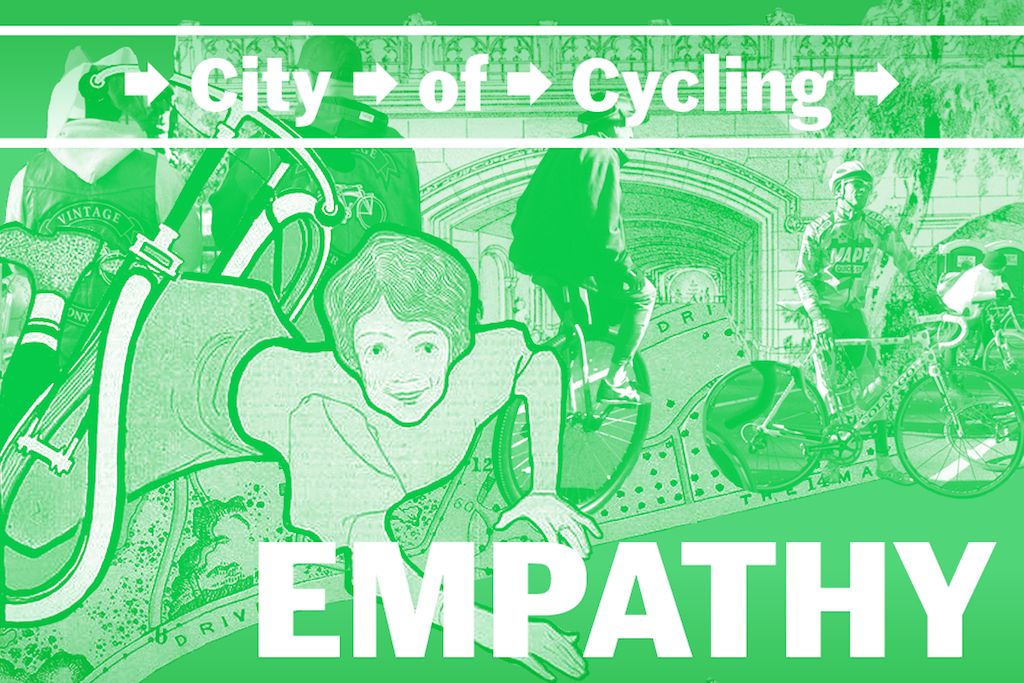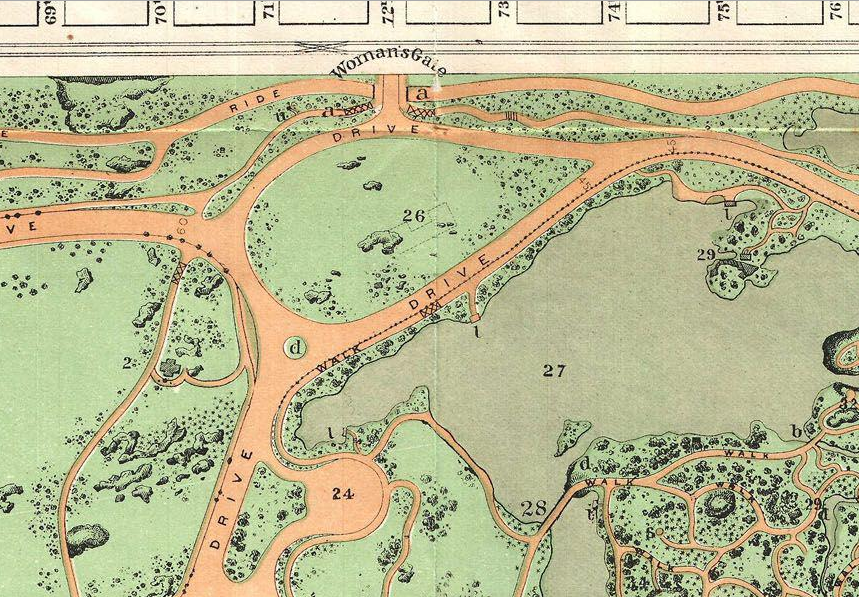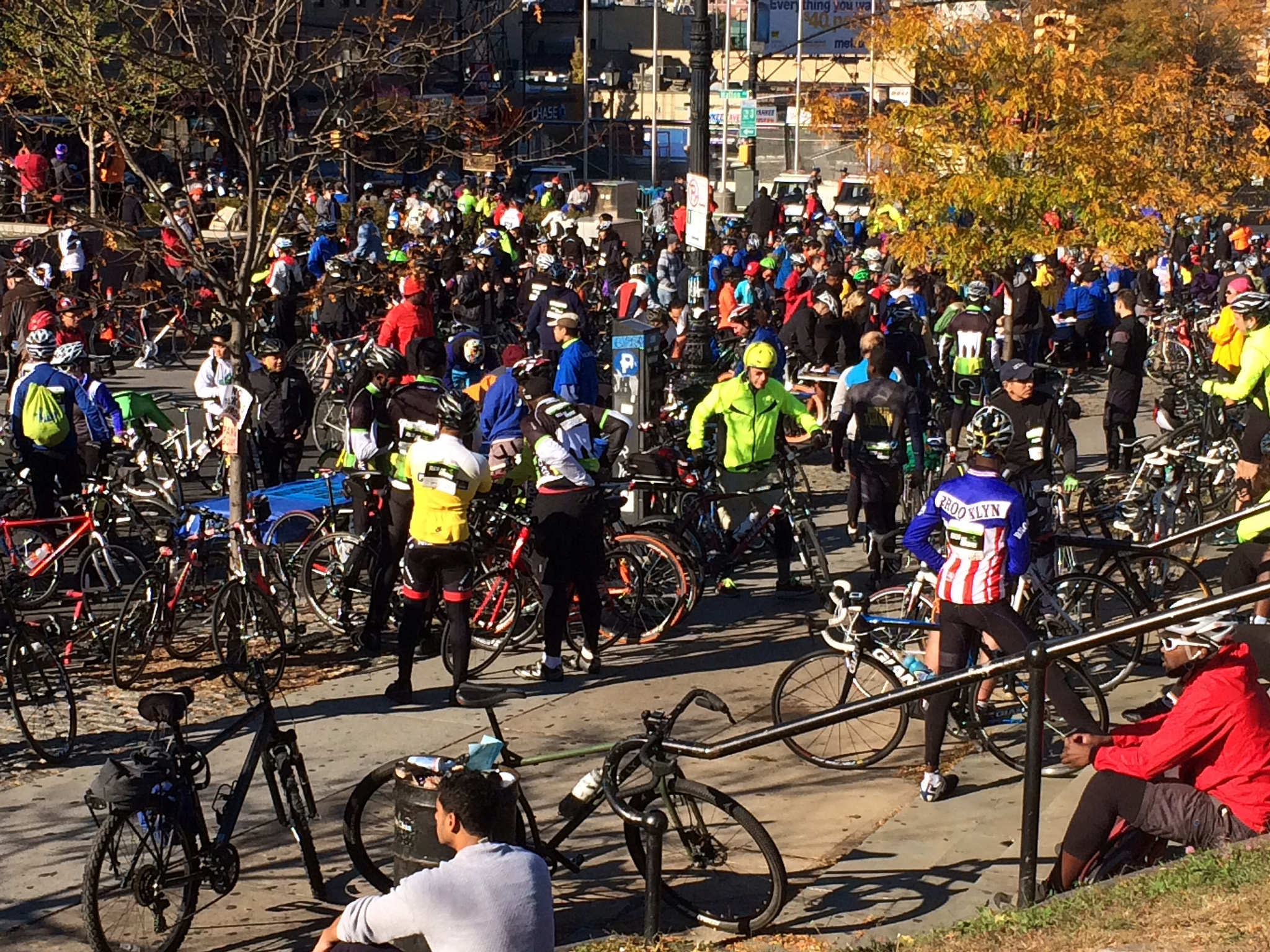City of Cycling
A look at how pedal-pushing can redefine urban space. Guest-edited by SLO Architecture.
In This SeriesWe are celebrating 15 years — and counting — of stories that are deeply researched and deeply felt, that build a historical record of what the city has been.
Urban Omnibus is pleased to present the final installment in the series City of Cycling, in partnership with guest editors Alexander Levi and Amanda Schachter. Alex and Amanda, co-principals of SLO Architecture and daily bikers, illuminate the cyclist’s New York — its speed, its networks, and the empathy its congested spaces demand from all of us. –U.O.
City of Cycling takes on the current state of New York City cycling and how pedal-pushing can redefine urban space. In the last ten years, bike ridership has grown exponentially, thanks to the success of bike share programs, the ongoing expansion of a five-borough network of protected bike lanes, and an increasing desire to find more environmentally sound solutions to everyday getting around. Cycling is becoming a critical form of local travel, reshaping the city’s transportation infrastructures. At the same time, the reality of 50,000 daily cyclists running up against the pre-existing automobile-centered network is spurring conflict among users. As urban space evolves, diverse city-dwellers might feel either included or marginalized by alternate modes of movement.
The three installments of City of Cycling look at already-realized bicycling initiatives and those currently making headway, delving into long-term aspirations and experimental proposals in development by city agencies, advocacy groups, and private citizens. –SLO
You come to realize that you have been given an incredible gift. … The blessing of perspective. The blessing of compassion. The blessing of understanding … But most importantly, you have been given the blessing of empathy, the ability to relate to other people… to understand the challenges of other people. … to connect with others.
— Justice Richard H. Bernstein, on being blind and relating to others, 2015
Imagine this: you’re riding a bicycle in the street, when the driver just ahead pulls over to drop off a passenger. You swerve, while the car behind approaches, forcing you into the narrow space between lanes, grazing your handlebar with a passing side view mirror, knocking you to the ground. In that moment as you arc toward the asphalt, you ask yourself: whose freedom of motion is being exercised, and whose is being curtailed?
Everyone feels vulnerable to split-second changes of mind on a densely traveled street. The cyclist, pedaling the city’s leftover space, might be the most attuned to danger, but the driver also worries about doing harm. While they face analogous challenges, driver and cyclist — and pedestrian — see themselves in different worlds, threatened by the other’s unpredictable actions, rather than finding common ground through empathy.
In his “Theory of Moral Sentiments,” Adam Smith observed that our ability to place ourselves within another’s frame of reference is what makes us moral beings. We “become in some measure the same person with him, and thence form some idea of his sensations, and even feel something which, though weaker in degree, is not altogether unlike them.”
Writing in 1759, a century before the term “empathy” was first coined by psychologists to describe people’s capacity to internalize a work of art, Smith revealed a great potential within us. We are hardwired to put ourselves in one another’s shoes. We can feel empathy even when the sense of connection begins as a flight of fancy. The question is: how do we activate our capacity to internalize other perspectives, in order to create an urban environment that makes room for multiple, simultaneous modes of mobility, out on the streets where we interact every day?
The first step toward an urbanism of empathy involves guaranteeing everyone sufficient space to circulate free of danger. Moving around safely requires us to anticipate the moves of those around us, as though those movements were our own. Everyone is inherently multi-modal: driving one evening, in a wheelchair the next; at the wheel of a truck in the morning, then riding in the back of an ambulance in the afternoon; pedaling a bicycle for a while and back on foot again. In short: there are no cyclists or drivers, only people who at a given moment happen to be on bicycles or in cars.
To see and value the possibilities of a shared freedom of motion through mutual respect, consider Justice Richard Bernstein. The first blind justice elected to the Michigan Supreme Court, an Ironman triathlete and marathoner, Bernstein was training in Central Park in 2012 when he was struck by a cyclist. From where he lay face down on the asphalt with broken teeth and bones, he listened to the apology and distress in the cyclist’s voice, and had the presence of mind to consider the poor layout of the park’s bike lanes as the culprit, proceeding to sue the City of New York for a safer park.
Bernstein turns the preconception of the disabled as disempowered on its ear: the challenged don’t need our empathy; in fact, it is their heightened empathy that strengthens and expands the democracy of shared space. The vulnerability of the cyclist can likewise challenge us to bring equity to our urban environment. Legislation and design creating space for cycling can pave the road to empathy among all city dwellers.
In Central Park, a microcosm of New York City’s web of traffic, every type of vehicular interaction unfolds within an increasingly unpredictable landscape. 42 million visitors a year share 843 acres while trying not to run into — or over — one another. In 2014, in an attempt to restore safety and empathy between pedestrians and cyclists after two fatal collisions threatened to pit the park’s users against one another, Matt Falber founded the Central Park Arch Project. His goal: to convince the Central Park Conservancy to restore Frederick Law Olmsted and Calvert Vaux’s original plan for the park, a model of well-planned, non-intersecting circulatory systems, where anyone, in any number of itineraries, could feel at home.
Olmsted and Vaux’s winning design for the park, the “Greensward Plan,” was forward-thinking. While the other 32 entrants in the 1857 competition presented at-grade intersections at the four roadways that crossed the park, only Olmsted and Vaux thought to bury the transverse roads beneath the parkscape, under planted archway-tunnels. The park could thus function as a seemingly limitless bucolic environment while city traffic coursed beneath it, uninterrupted. Olmsted and Vaux extended their concept of independent roadways throughout the park itself, assigning each type of circulator — whether horse-drawn carriage, equestrian or pedestrian — to a distinct pathway that would cross over other routes and under the archways. Each mode of motion would unfold independently in its own space and scenography, allowing everyone to move freely. It was one aspect of Olmsted’s “democratic development of the highest significance,” as he called the park, open to all comers.
After Robert Moses became New York City Parks Commissioner in 1934, he “modernized” the park, realigning roads and removing arches that stood in the way of faster car traffic. Nowadays, many people seem to prefer to follow and cross the Central Park Drive, the principal roadway looping around the park, at grade, even without a signed crosswalk. The loop is traveled mainly by recreationists on bicycles, rollerblades, and skateboards going at high speed, as well as by horse-drawn carriages, pedicabs, and runners moving in two directions, making crashes and near-misses all but inevitable.
Meanwhile, outside the park, cyclists are seeking a three-foot rule, a law requiring drivers to maintain at least a three-foot berth when passing cyclists on area roads. More than 18 states already have a law of this kind in effect, requiring from two to six feet of passing space. New York State’s current law is ambiguous about distance, stating: “The operator of a vehicle overtaking, from behind, a bicycle proceeding on the same side of a roadway shall pass to the left of such bicycle at a safe distance until safely clear thereof.”
Here, legislation, education, and enforcement can build empathy; these work together to create official, distinct paths of travel and, as a consequence, change minds about the legitimacy of cycling as a mode of transportation. In other words: call for change, pass the law, add it to driver’s education and the driving test, then give police something to enforce, and reinforce, out on the road. In the end, hearts will have to change to align with shifts in culture and forces of habit due to advances in the law. In Central Park, Justice Bernstein’s suit to call for safer street design has already brought about some improvements: space along the Park Drive has been redistributed and apportioned in incremental bands of increasing speed.
The key to empathy is overcoming preconceptions about who actually bikes in the city, and why. People who pit themselves against cycling and bike infrastructure — whether against slow or fast cycling, or signage, striping, bike lanes, or racks — often fall back onto stereotypes. They might disparage the archetypical “middle-aged man in lycra,” maligned as a stuck-up member of the leisure-class who aspires to breaking land-speed records and traffic law, when that speedster may be seeking recovery by pedaling his way back to health. Or they might see biking itself as a form of gentrifying invasion, claiming that bike share is an elite system unavailable to struggling families in the Bronx, outer Brooklyn and Queens, or Staten Island. Yet when bike share stations do finally reach such neighborhoods, they are quickly judged to be a sign of the loss of authentic community in the face of market speculation.
Other opponents of cycling and bike infrastructure call on seemingly contradictory stereotypes to argue the same misguided case — claiming, for example, that introducing bike lanes lowers property values and threatens public safety by bringing “undesirables” into a neighborhood. These detractors ignore the fact that, in actuality, the restaurant meals they order at dinnertime arrive on the backs of cyclists who would benefit from the safety of the same bike lanes the diners reject.
So long as we refuse to envision ourselves ever riding or needing a bike, empathy for cyclists will suffer. Bill Rodgers, who won the first three New York City Marathons to be run out on city streets in 1977, ’78, and ’79, pointed out how important it was to get runners out of Central Park and onto the street to show the public that, rather than a rarefied pastime, running was universal. If only for a single day, Rodgers said, running could take center stage throughout the city.
The Tour de Bronx might prove to be the single day that universalizes cycling, not only for habitual urban cyclists, but for all who travel the streets. Each fall, thousands come out to ride 25- and 40-mile courses across the Bronx, in what is reportedly the largest free mass-cycling event in New York State. Unlike the spring Five Boro Bike Tour and the fall T.A. Century, the Tour de Bronx is within reach of absolutely anyone who wants to come out and pedal the streets. As part of Vision Zero, the city’s Department of Transportation even hands out free bike helmets before the ride.
This October, we rode in the Tour alongside 7,000 other cyclists, ranging from lycra-clad road-bikers and leather-jacketed custom cyclists, to youths on first bikes, messengers on day-off fixies, artists on reinvented frames, GoPro-sporting documentarians-on-wheels, acrobats on three-foot diameter unicycles, coworker groups and weekend hobbyist clubs on matching set-ups, and even the Borough President on a hybrid. Here, visible to all on the street, riders of all vocations, incomes, ethnicities, origins, languages, orientations, personalities, ages, and places of residence, on everything from featherweight carbon frames to lovingly restored and ornamented vintage cycles, and nearly every variant of pedal-powered wheeled contraption imaginable, converse congenially and share the road.
Since most roads along the Tour de Bronx route remain open to traffic, we saw a reversed dynamic emerge between cars and bikes from time to time. So many cyclists rode together along some stretches that lone drivers might be swarmed by the pedal-powered pack. The cars seemed lost amid the bikes, as if having taken a wrong turn somewhere — much like when a bike lane falls away and a cyclist finds herself in the middle of a divided highway, engulfed by speeding cars.
Meanwhile, traveling in a pack, the bikes became a convoy that protected and escorted the cars safely along. In this upside-down moment, drivers and cyclists experienced a simultaneous, mutual empathy: drivers imagined the precarious solitude of the cyclist in rush-hour traffic, while cyclists unexpectedly felt the comfort and power to preside over the roadway and shape circulation.
In this instant, visions of the future flashed before us. We saw a day when bicycle traffic would flood boulevards and highways, while lone cars would navigate green lanes as afterthoughts along narrow shoulders. Then we imagined balance on the road, where those on four wheels would drive like the cyclists we were that day: vigilant, connected, reading the patterns, engaged and ever ready to shepherd others along the way.
An urbanism of empathy suggests that each person isn’t just out for herself, but reads and guides the patterns of the road as a whole, embracing a broader perspective. As a teenager, Frederick Law Olmsted was rendered temporarily blind by sumac poisoning, halting his studies and abruptly upsetting the order of his life. Perhaps this early trial bestowed Olmsted with an enhanced empathetic perspective; he envisioned Central Park as a space where personal experiences could unfold freely in coexistence with others. On the road, our interdependence can help us to resist detachment, and open us up to a shared vision of the city.
The views expressed here are those of the authors only and do not reflect the position of The Architectural League of New York.
A look at how pedal-pushing can redefine urban space. Guest-edited by SLO Architecture.
In This Series


![New York City Marathon Runners in Central Park, 1982. | Image via <a href="http://collections.mcny.org/Collection/[Runners%20in%20the%20New%20York%20City%20Marathon%20in%20Central%20Park.]-2F3XC5UX5UPB.html">Museum of the City of New York</a>](https://urbanomnibus.net/wp-content/uploads/sites/2/2016/11/marathon-cropped.jpeg)
